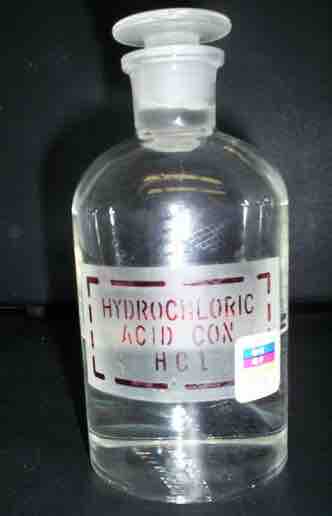Identifying Acid and Conjugate Base Pairs
A buffer is an aqueous solution consisting of a mixture of a weak acid and its conjugate base or a weak base and its conjugate acid. Therefore, it is very important to be able to identify acid and conjugate base pairs. The conjugate acid is created by accepting (adding) a proton (H+) donated by the conjugate base.
A buffer's pH changes very little when a small amount of strong acid or base is added to it. Therefore, it can be used to prevent change in the pH of a solution. Buffer solutions are used as a means of keeping pH at a nearly constant value in a wide variety of situations.
One of the main requirements of a buffer is that it have the capacity to control pH after the addition of a reasonable amount of acid or base. In other words, there must be a large-enough concentration of acetic acid in an acetic acid/acetate ion buffer, for example, to consume all of the hydroxide ions that may be added.

Hydrochloric acid
A container of concentrated hydrochloric acid (HCl).
Calculating the Final pH
A concentrated buffer can neutralize more added acid or base than a dilute buffer, because it contains more acid/conjugate base. However, any buffer will lose its effectiveness if too much strong acid or base is added.
Example:
Calculate the pH change when you add 1.0 mL of 1.0 M HCl to 1.0 L of acetic acid/sodium acetate buffer with [HC2H3O2] = 0.70 M and [C2H3O2-] = 0.60 M.
Next, calculate the pH change for a buffer with [HC2H3O2] = 7 mM (7 x 10-3 molar) and [C2H3O2-] = 6 mM (6 x 10-3 molar). The Ka for acetic acid is 1.8 x 10-5.
Solution:
The balanced equation for the buffer is:
The ICE table for the reaction is:

ICE table for the reaction of acetic acid in water
ICE table showing the concentrations of acetic acid, a hydrogen ion, and the acetate ion.
The acid dissociation constant is:
Solving for x using the quadratic equation, we get [H+] = 2.1 x 10-5 M. Therefore, the pH for the buffer with an acid/base concentration of 0.7/0.6M is 4.68.
HCl is a strong acid that is fully ionized in water. We only need to account for the fact that it supplies [H+] and reacts completely with the base in solution. The change in the concentrations after the reaction is:

ICE table for the addition of HCl to a solution of acetic acid
Acetic acid after the HCl is added.
Once again, using the acid dissociation constant, we can solve for x to get [H+] = 2.11 x 10-5 M. Therefore, the pH for the buffer with an acid/base concentration of 0.7/0.6M after the addition of HCl is 4.68.
Finally, we repeat the calculation for the buffer with 7/6 mM after the addition of HCl. We know from the Henderson-Hasselbalch equation that the ratio of the concentration of the buffer determines the pH rather than the concentration. Therefore, the pH of the weaker buffer before the addition of HCl is the same.

ICE table for the addition of HCl to acetic acid using smaller initial concentrations.
ICE table for the buffer solution of acetic acid with 7/6 mM after the addition of HCl.
Using the same equations as above, we get [H+] = 2.80 x 10-5 M, which gives a pH of 4.54. In this case, the pH changes more dramatically.